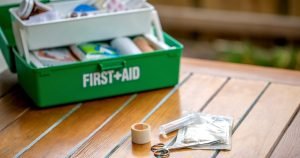Fingertip injuries are common, and learning the fingertip bandages and how to apply them can make a difference in healing.
This comprehensive guide will delve into the unique design of fingertip bandaids, proper wound preparation, and the correct application of the bandaid on a fingertip. Moreover, we provide alternative bandaging methods when a specialized bandage is unavailable.
Key Takeaways
- Fingertip bandages are in the shape of hourglass and conform nicely to fingertips. They come in various forms which differ in size, material and color.
- When applying a fingertip bandage, ensure proper wound preparation and a secure yet comfortable fit. Replace daily & use waterproof protector when needed.
- When a specialized fingertip bandage is not available, consider using gauze pad/non-stick pad with adhesive tape or modifying a standard bandage strip.
Understanding Fingertip Bandages
Fingertip bandages are specifically designed adhesive bandages to address the challenges of covering a wound on your fingertip, providing better protection and comfort than standard bandages.
Fingertip Bandage Design
A fingertip bandage has a unique hourglass shape design that caters to the contours of your fingertip, ensuring a secure fit while allowing unrestricted movement.
The main components of the fingertip bandages are the same as those of regular adhesive strips: a non-stick pad to cushion the wound, an adhesive sheet made of plastic or fabric for secure placement, and release liners to maintain its stickiness until application.

Types of Fingertip Bandages
Fingertip bandages come in various sizes and shapes, subtly varying based on the manufacturer. These bandages are typically crafted from either plastic or fabric material, each offering unique advantages in terms of flexibility and durability.

Notably, bandages are often distinctly blue for easy identification and safety in specific industries such as food preparation.

Applying the Fingertip Bandage
The section will guide you through applying the bandage on the fingertip.
Step 1: Preparing the Wound
Before you apply a fingertip bandage, thoroughly cleaning and drying the wound is necessary to ward off infection and foster healing.
To minimize the risk of infection, clean your fingertip with running water. Carefully dry the wound once you’ve washed your fingertip to avoid additional irritation. Pat the wound dry with a clean towel or let it air dry.
Step 2: Positioning the finger on the bandage
Remove the release liners from the adhesive sheet of the fingertip bandage. Place your wounded fingertip on the white non-stick pad, ensuring it covers the wound completely.
Step 3: Wrapping the adhesive strips securely
Start by wrapping the bottom wings of the bandage around your finger. Then, fold the top half over and wrap the wings around.
Ensuring a comfortable fit
The proper functioning of a fingertip bandage depends on its comfortable fit. While the bandage should be secure, it must not be too tight, which can restrict blood flow and cause discomfort. If you notice any of the following symptoms, it is crucial to adjust the bandage accordingly to ensure proper circulation:
- Discoloration
- Numbness
- Tingling
- Pain
Alternative Methods to Using Specialized Fingertip Bandage
In some situations, a specialized fingertip bandage may not be readily available. In such cases, alternative methods can be employed to cover and protect your fingertip wound.
The following sections explore two alternatives: employing a wound pad with adhesive tape and modifying a conventional strip bandage.
Method 1: Wound dressing pad and adhesive tape
A wound dressing pad such as a gauze or non-stick pad and adhesive tape can be a makeshift fingertip bandage when a specialized bandage is unavailable. Here’s how to do it:
- Place a wound dressing pad directly on top of the wound.
- Secure it by wrapping adhesive tape around the fingertip, ensuring the tape is snug but not too tight to allow proper circulation.
- Trim any excess tape if necessary.
Method 2: Modifying a standard bandaid strip
Another alternative is to modify a standard strip bandage to fit the contours of your fingertip better. To do this, follow these steps:
- Carefully cut a lengthwise slit down the center of each adhesive end of the standard strip bandage.
- Wrap the adhesive strip around your fingertip, using the slits to help it conform to the shape of your finger.
- Ensure that the white non-stick pad is placed at the center of the bandage directly over the wound for optimal coverage.
Below is a video by wikiHow that provides a detailed illustration.
Frequently Asked Questions
What is the meaning of a fingertip bandage?
A fingertip bandage is an adhesive wound dressing designed to fit the contours of a fingertip, allowing unrestricted movement while protecting minor wounds. It has an hourglass shape to ensure secure adhesion, making it ideal for treating cuts, burns, scrapes, and other light wounds.
What is the main difference between a fingertip bandage and a regular bandage?
Fingertip bandages are designed to fit the contours of a fingertip for more secure coverage than regular bandages, which may not provide the same level of comfort or protection.
How often should I change my fingertip bandage?
Change your fingertip bandage daily for optimal healing. If it becomes wet or soiled, replace it more frequently.
How do you waterproof a finger wound?
If you need to expose your wounded finger in a wet situation, consider using a finger cot temporarily to cover the affected area. However, avoid wearing the finger cot for an extended period as it may hinder healing.
Reference
wikiHow. (n.d.). How to put a bandaid on your fingertip: 12 steps (with pictures). wikiHow. https://www.wikihow.com/Put-a-Bandaid-on-Your-Fingertip



